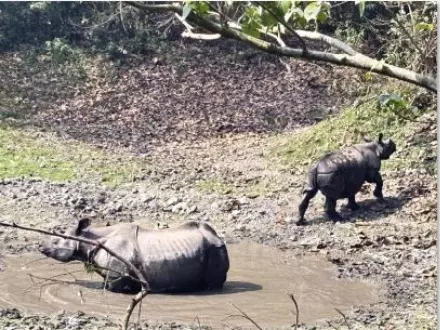Forest dept seeks expert help to boost genetic diversity among North Bengal’s rhinos

Jalpaiguri: In a bid to address long-standing concerns about genetic stagnation leading to inbreeding among one-horned rhinoceroses in North Bengal, the Forest department has turned to the Wildlife Institute of India (WII) for expert assistance. The initiative aims to introduce genetic diversity in the rhino populations of Jaldapara and Gorumara National Parks, where inbreeding has remained a critical issue for over a century.
For decades, rhinos with shared genetic lineages have inhabited these protected areas, resulting in minimal genetic variation and associated challenges. Officials believe this lack of diversity leading to inbreeding has affected the overall health and reproductive success of the animals, including a skewed male-to-female ratio and premature deaths despite the species’ natural longevity of over 40 years. To counter these issues, the Forest department is considering intra-regional rhino exchanges between Gorumara and Jaldapara. The plan is to facilitate natural breeding among genetically varied individuals by transferring rhinos between the two parks. Talks are also underway to once again source rhinos from Assam, a strategy first attempted in the 1990s.
“We have initiated discussions with experts at the Wildlife Institute of India to formulate a scientifically guided breeding programme,” said Bhaskar JV, Chief Conservator of Forests, North Bengal Wildlife Division. “A ‘Rhino Management Project’ has been launched to encourage genetic variation through strategic cross-breeding. Our goal is to enhance the vitality and reproductive success of the species in this region.”
Historical attempts to introduce new bloodlines had limited success. In the 1990s, two male rhinos were translocated from Assam — one each to Jaldapara and Gorumara. However, the local rhinos did not accept them and the initiative was eventually abandoned. The males were later returned to the Alipore Zoo in Kolkata. Despite steady growth in overall numbers — Jaldapara’s rhino population surged from 14 in 1985 to 331 in the 2025 census, while Gorumara grew from 18 in 1998 to 61 this year — imbalances persist. The female population consistently outnumbers males and newborns’ genders are not always identified in time to inform population management strategies.
According to Forest department records, the male-to-female ratio, though slightly improved — from 0.959 in 2019 to 1.327 in 2022 — still falls short of a balanced demographic. Experts believe that with well-managed breeding interventions and inter-regional cooperation, the rhino populations of North Bengal could see significant genetic revitalisation in the coming years.



